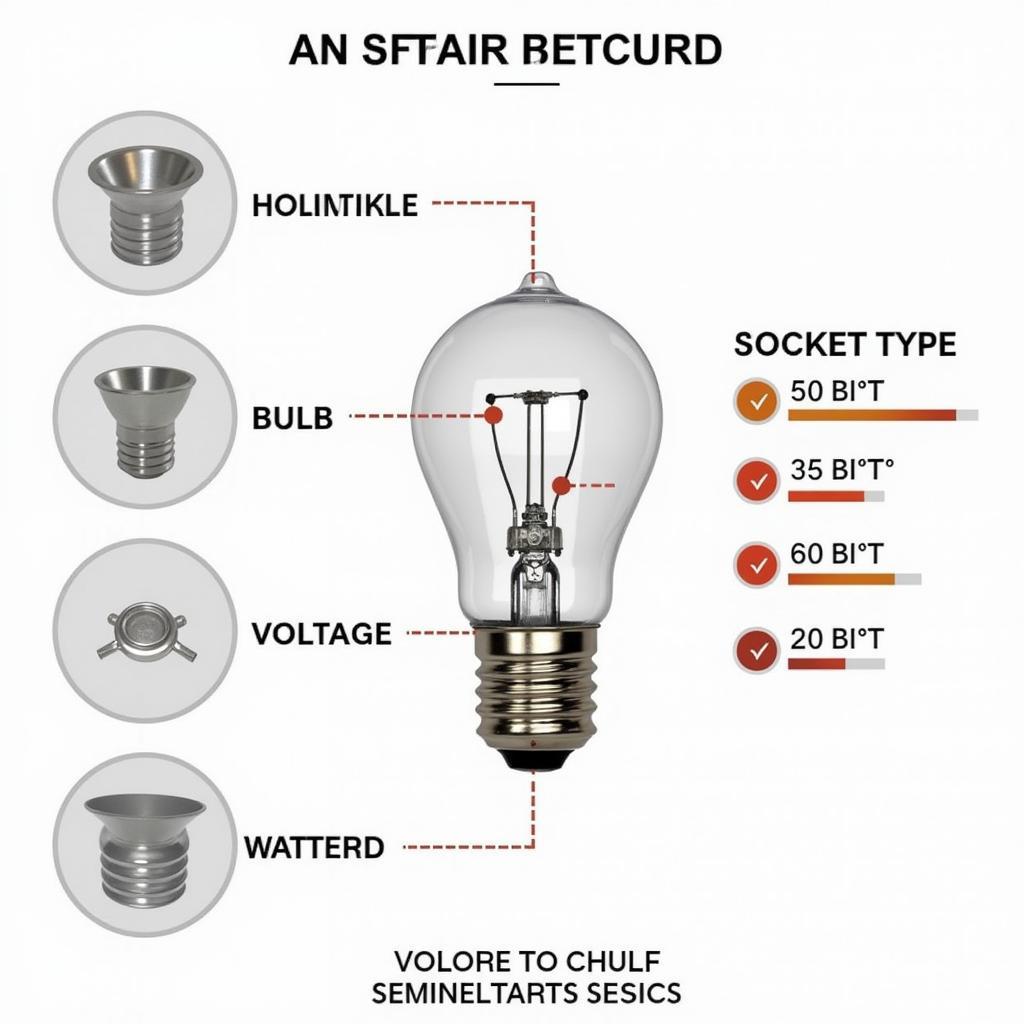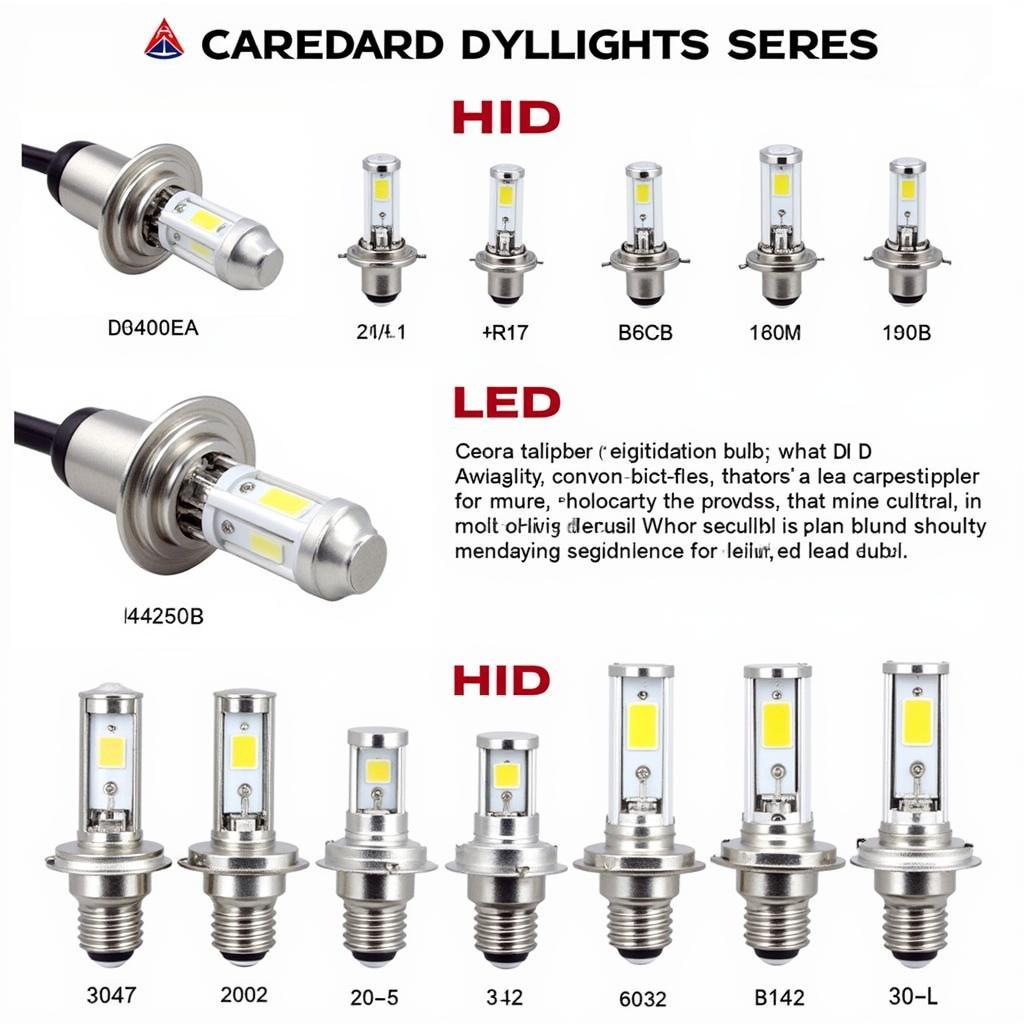Understanding the ins and outs of your American car’s lighting system can feel like navigating a maze. From deciphering cryptic owner’s manuals to choosing the right replacement bulbs, it’s easy to feel overwhelmed. But worry no more! This comprehensive guide will illuminate everything you need to know about American car light bulb detail charts, empowering you to confidently maintain your vehicle’s illumination.
Why Understanding Your Light Bulb Detail Chart Matters
Your car’s light bulb detail chart is more than just a list of numbers and letters. It’s the key to unlocking a safer, more enjoyable driving experience. Here’s why:
- Safety First: Properly functioning headlights, taillights, and turn signals are crucial for safe driving, especially at night or in adverse weather conditions.
- Avoiding Tickets: Driving with a burnt-out bulb can result in a traffic ticket and fines. Knowing your bulb specifications helps you avoid this.
- DIY Empowerment: A light bulb detail chart empowers you to replace bulbs yourself, saving you time and money on mechanic visits.
Deciphering the Code: How to Read a Light Bulb Detail Chart
A typical American car light bulb detail chart might seem confusing at first glance, but it’s actually quite logical. Here’s a breakdown of the key elements:
1. Bulb Type: This section indicates the specific type of bulb used in each light fixture. Common types include:
- Halogen: Affordable and widely used, offering a warm, yellowish light.
- LED: Known for their long lifespan, energy efficiency, and bright, white light.
- Xenon (HID): Produce a powerful, bluish-white light and are often found in high-end vehicles.
2. Bulb Socket: This refers to the shape and size of the bulb’s base, ensuring a secure fit in the headlight housing. Common socket types include:
- 9005/9006 (HB3/HB4): Often used for low and high beams, respectively.
- H11/H9: Frequently found in fog lights and low beam headlights.
- D1/D2/D3/D4: Commonly used in HID headlight systems.
3. Wattage: This measures the amount of power the bulb consumes. Higher wattage generally means brighter light, but it also generates more heat.
4. Voltage: This indicates the electrical voltage the bulb is designed to operate on. Most car bulbs use a 12-volt system.
5. Color Temperature: Measured in Kelvins (K), this determines the color of the light emitted. Lower Kelvin ratings (2700K-3000K) produce a warm, yellowish light, while higher ratings (4000K-6000K) offer a cooler, bluish-white light.
 American Car Light Bulb Chart Example
American Car Light Bulb Chart Example
Where to Find Your Car’s Light Bulb Detail Chart
Locating your car’s light bulb detail chart is usually straightforward. Here are the most common places to check:
- Owner’s Manual: Your car’s owner’s manual should have a dedicated section outlining the light bulb specifications.
- Driver’s Side Door Jamb: Many American car manufacturers place a sticker inside the driver’s side door jamb that lists the bulb sizes.
- Online Resources: Reputable online auto parts retailers often have vehicle-specific light bulb guides.
Common American Car Light Bulb Types and Their Applications
Understanding the specific applications of different light bulb types can help you make informed choices when it’s time for a replacement:
1. Headlights: Responsible for illuminating the road ahead, headlights are crucial for safe night driving. They typically use Halogen, HID, or LED bulbs in various configurations, such as H11, 9005, 9006, or D1S.
2. Taillights: These red lights at the rear of your car alert other drivers when you’re braking or driving at night. They commonly use incandescent bulbs, although LED taillights are becoming increasingly popular.
3. Turn Signals: These amber lights indicate your intention to turn or change lanes. They typically use incandescent bulbs, but LED versions are gaining traction due to their faster response times.
4. Fog Lights: Designed to improve visibility in fog, rain, or snow, these lights are typically located low on the front bumper and often use H11 or H8 bulbs.
5. Daytime Running Lights (DRLs): These lights, usually white or amber, automatically illuminate when the engine starts, enhancing visibility during the daytime. They often use LED bulbs for their energy efficiency and long lifespan.
 American Car Headlight Bulb Types
American Car Headlight Bulb Types
Tips for Choosing the Right Replacement Light Bulbs
When it’s time to replace a burnt-out bulb, keep these tips in mind:
- Consult Your Detail Chart: Always refer to your car’s light bulb detail chart for the correct bulb specifications.
- Consider Upgrading to LEDs: LEDs offer increased brightness, longevity, and energy efficiency compared to traditional incandescent bulbs.
- Choose Reputable Brands: Opt for well-known brands known for quality and performance to ensure optimal light output and lifespan.
- Seek Professional Installation (If Needed): While replacing most car light bulbs is a relatively straightforward DIY task, some vehicles may require professional installation, especially for HID or LED systems.
Expert Insights
“Many car owners overlook the importance of regularly checking and replacing their vehicle’s light bulbs,” says John Smith, Senior Automotive Technician at XYZ Auto Repair. “A burnt-out headlight or taillight can significantly compromise visibility and increase the risk of accidents, especially during nighttime driving or inclement weather.”
Smith emphasizes the importance of using the correct bulb type and wattage specified in the car’s detail chart. “Using the wrong bulb can not only affect lighting performance but also potentially damage the vehicle’s electrical system,” he adds.
Conclusion
Your American car’s light bulb detail chart is an indispensable tool for maintaining optimal visibility and ensuring a safe and enjoyable driving experience. By understanding how to read and interpret this chart, you can confidently choose the right replacement bulbs and keep your vehicle’s lighting system in top condition. Remember, a well-lit car is a safer car, both for you and your fellow drivers on the road.
FAQs about American Car Light Bulbs
1. Can I replace my own car light bulbs?
Replacing car light bulbs is generally a straightforward DIY task. However, some vehicles and bulb types, such as HIDs, may require professional installation.
2. What are the benefits of LED car lights?
LED car lights offer numerous advantages over traditional incandescent bulbs, including increased brightness, longer lifespan, improved energy efficiency, and faster response times.
3. How often should I replace my car’s light bulbs?
While bulb lifespan varies, it’s generally recommended to check your headlights, taillights, and turn signals every 12 months or 12,000 miles and replace any burnt-out bulbs promptly.
4. What happens if I use the wrong wattage bulb in my car?
Using a bulb with the incorrect wattage can result in dim lighting, electrical problems, or even damage to your car’s wiring or headlight housing.
5. Where can I dispose of old car light bulbs?
Avoid disposing of old car light bulbs in regular household trash. Check with your local recycling center or auto parts stores for proper disposal options.
Need Help? We’re Here for You!
Have questions about your American car’s light bulb detail chart or need assistance finding the right replacement bulbs? Don’t hesitate to contact our team of automotive experts.
WhatsApp: +1(641)206-8880
Email: [email protected]
We’re available 24/7 to provide personalized support and guidance.

Leave a Reply